RECENT UPDATES TO THIS SITE INCLUDE: SOME ADDITIONS TO OUR MILLS WAGONS PAGE; SEVERAL MORE SUPER-DETAILED LOCOS AND SOME GENERAL AMENDMENTS ON OUR BEESON PAGE; AND AN ADDITIONAL EXLEY LOCO AND A LEEDS ONE. I HAVE ALSO ADDED A SMALL NOTE ON DETTMAR'S ROLE IN PROMOTING SKATE PICKUP SYSTEMS, WHERE THEY SEEM TO HAVE BEEN A KEY CONTRIBUTOR. THE REALISATION OF THEIR IMPORTANCE HELPS CONFIRM MY PREVIOUS UNDERSTANDING THAT THIS TYPE OF RUNNING WAS PRIMARILY A POST-WAR DEVELOPMENT. This site has two main purposes. The first is to provide an introduction to model railway products sold under the Milbro trademark by the UK Sheffield-based firm of Mills Bros., both before and after World War Two. The second is to complement and supplement this account by adding to the information available via the internet about railway models, mechanisms, accessories and motors made by several other UK firms between the 1920s and 1970s. At time of writing, some material is included on Bassett-Lowke, Beeson, Bond's, Dettmar, Douglass Models, Exley, Gresham Models, Hunt, Leeds, Miller Swan, Vulcan of Kendal, Windsor Models, Walker & Holtzappfel, and others. As time has passed, our coverage of some makers has grown quite extensive, as I have tried to make the site useful for more 0 gauge enthusiasts, and to capture a little of the history. The UK Mills Brothers company was referred to initially in its catalogues simply as Mills Bros., and described as a Model Railway and Commercial Model Builders. Then, from 1935-36 until the late 1940s, it was referred to formally as Mills Bros. (Model Engineers) Ltd. Finally, following ownership changes and what seems to have been a division of functions between model railway work and model aero-engine production, the model railway activities were continued through the 1950s under the name of Mills Bros. (Sheffield) Ltd. (For more about the firm after the war see our Milbro Locomotives section.) The company operated primarily from Sheffield premises, their most well-known address being in St. Mary's Road (where they were based from February 1930 onwards). The telephone number from that address was used as one of the numbers offered in the Milbro range of wagon transfers, and is often seen on their factory-built vehicles (25742). The general aim for this website is to discuss and illustrate a range of items in a way that may interest model railway enthusiasts and collectors, especially those involved with vintage 0 Gauge toys and models. The site is maintained and developed by Malcolm Harrison, with advice on some of the content from other enthusiasts with knowledge of vintage trains, and with technical/computing support from Gill Harrison. Illustrative materials and text have been added gradually to the site (a process which began in November 2013). This is a not-for-profit enterprise, initially begun to help fill a gap in what was currently available about Milbro trains, but increasingly also trying to provide material that might be helpful for people investigating other firms from the vintage era. Over time a considerable archive has been developed on this site of photographs of model railway locomotives and rolling stock. It is hoped this will be helpful for future enthusiasts and researchers interested in the history of this hobby. 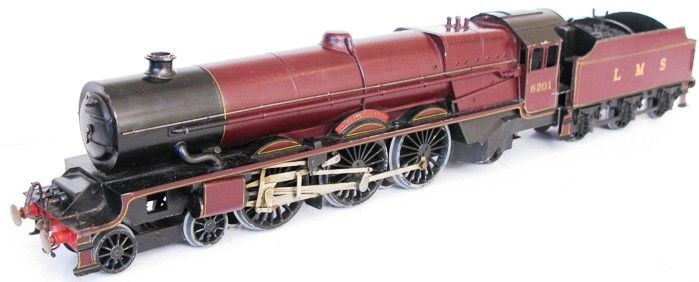
Illustration H2a. A Milbro LMS Princess and tender. Many thanks to the owner of this model for letting me show it on this website. The firm catalogued a loco of this class in the 1930s, and the example in our photograph was most likely made at the end of that decade. There are more pictures of this engine in our page on Mills locomotives.
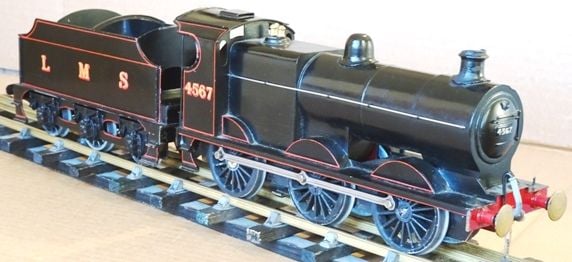
Illustration H2b. Milbro LMS 4F loco and tender. This is probably one of a batch made in the 1930s. Although very plain in terms of detailing, the model is well proportioned and neatly put together. There are more pictures of this loco in our Mills Locos page (as well as another later 4F to which Milbro may have contributed). 
Illustration H2c. Milbro 0 gauge NE atlantic loco, probably from the early 1930s or late 1920s.
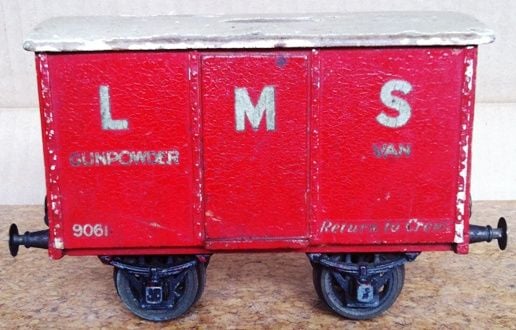
Illustration H3a. Milbro 0 gauge gunpowder van. An example from the large range of wooden rolling stock produced by the company. This particular model is probably from the late 1920s or early 1930s. 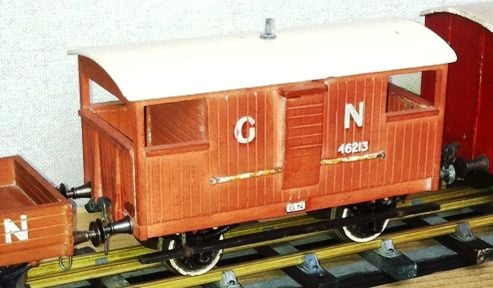
Illustration H3b. A rare example of a Milbro GN brake van. This is in good condition, with its trade mark intact. I do not know of any catalogue picture of this vehicle. 
Illustration H4. This Milbro compound has been through a number of changes since it was made in the earliest period of the firm's loco production. The high-quality paintwork is apparently from the 1960s-1980s, and at some date the model was converted very carelessly to two-rail running. The loco was later restored to 3-rail, and some other issues were dealt with. Correct Leeds-style wheels were fitted, and in 2024 I at last put on a Mills pickup! I think parts for the tender body were probably supplied by Beeson.
This model is not true to prototype, and thus matches the one catalogued by Milbro, albeit with a changed number. The firm seems to have been less concerned with accurate representation when making some of its earliest models. I have never seen another compound model that is the same as the Milbro catalogue picture in terms of body details. Indeed, this one may be the actual model used for the catalogue image, albeit that it was subsequently given a new number.
Coverage of other firms Many of the photos shown on this site are of Milbro rolling stock, locomotives, accessories and associated published material or art work, but (in line with the intentions outlined above) models or components from other manufacturers and retailers are included too. This may help to fill gaps in what is available elsewhere, to provide context, to illustrate or explain, to show specific features, or to make comparisons. Feedback from some of the enthusiasts I know has indicated that the coverage given to items from other firms has been of interest, so the website sections on these have continued to grow in parallel with the Mills material. As far as locos in particular are concerned, I have been trying to identify and highlight some of the specific characteristics of models made by several makers. At the moment there are a few illustrations of wagons from LMC and two other producers within the section on Milbro Wooden Wagons, and something more extensive on several wagon-making firms in the page on wagons by other makers. There is also some general illustrative material on locomotives and motors from various UK firms in the section on Vintage Locos and Motors, together with separate coverage of two small-scale post-war firms, Douglass Models and Vulcan of Kendal. An additional section illustrates locos from Windsor Models and Exley, and we have also developed separate coverage of Bond's engines. The 3-rail (coarse-scale/standard scale) 0 gauge engines made by Beeson (including those sold through Milbro, Bassett-Lowke, Exley, Gresham Models and R.M.Evans) are discussed and illustrated in another section of the site. There is also a page about Bernard Miller/Miller Swan. The sections on Beeson and Miller are meant to help fill gaps in what is currently on the internet, where Miller in particular is under-represented, and where commentary on Beeson is scattered, brief or journalistic. The section on Milbro coaches is complemented by outline coverage of some other coach makers in another part of the site, and that material has been expanding as things have come to hand. In some parts of the site focussed on other locomotive makers in 0 gauge, I refer to features that might help with identification. Often the analysis is tentative rather than conclusive !  Illustration H5. Two LNER Claud Hamilton locos by Beeson, thought to be from batches made for Milbro. As with the locos in Illustrations H2b and H2c, these models are made in tinplate and were for gauge 0. The loco near to the camera was changed in a few relatively minor ways by a previous owner, and this included replacing the wires through the crank pins with something a little rough and ready, and replacing the pickups with a skate. When this picture was taken I was unaware that at some point the loco's nameplate had also been changed. The Claud Hamilton plate seen here is a later addition, glued on over the name 'John Herivel'. (See the Beeson section of this website for further comment.)
The model nearest the camera in the above picture (now discovered to be named John Herivel) was passed in 2024 to the Brighton Toy and Model Museum as a donation. I hope it might be of interest to model railway historians visiting the museum. In the future perhaps someone will be able to research it further, and see if it was linked in some way to the well-known codebreaker at Bletchley Park. 
Illustration H6. Milbro advertising placed on a practical item. Tape used by Milbro, carrying their name and address details. This piece was tied around one of their labelled boxes (see the section of our website that shows Artwork). Milbro track was something for which the company seems to have been well known, and some selected catalogue illustrations of track and related products are included in the section of the site that covers 'Other' Milbro items. Actual sections of 0 gauge track included in some photos, however, have a variety of retail origins. Renovations, rebuilt locomotives, and rolling stock repairs Vintage trains have often been changed in various ways over the decades since they were made. A loco might have been fitted with a new motor, repainted, modified, enhanced, or converted from 3-rail to 2-rail running. There might even have been a complete rebuild from one loco type to another by an enthusiast or commercial firm. When kits were available, that gave further scope for items that differed from a standard factory product (and in a sub-section further down this page we show a vehicle that was probably kit-built). Many of today's collectors, however, want an item to be in its original condition or fairly close to it, especially as far as the exterior appearance is concerned. With vintage locos, it can also be helpful to have the initial factory-built mechanism, as this helps identification. Repairs and renovations, however, are generally seen as acceptable, both on rolling stock and engines, and sometimes adding small details or commissioning a full repaint is felt worthwhile. In fact, quite a few collectors enjoy doing restorations (see the next two images below). We should also add that some loco rebuilds or major enhancements by professionals have firm places in the model railway history. In the Other Vintage Locos and Motors and the Douglass Models sections of this site we include some examples of 'rebuilds', as this is a part of the UK record which often gets forgotten. Professional rebuilding could fill significant gaps in the classes of locos available. I understand from an informant that a firm in Australia employed this strategy too, to 'repurpose' Bassett-Lowke models into Victorian Railways locomotives (see our section on Other Vintage Locos and Motors). 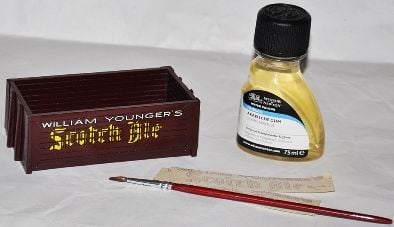
Illustration H7. People come into the field of vintage trains in all kinds of ways and some get enjoyment from repairing or improving things as well as from operating layouts or collecting models. This picture was provided by a Netherlands correspondent who had been turning a wrecked Mills wagon into a revived item for his layout, and making a very good job of it (with the help of original transfers and gum arabic) ! Some people prefer not to change the appearance of old models, so the usual advice is to keep (or 'touch in') original paintwork and transfers unless deterioration has gone too far (as it certainly had for the wagon above). The judgement is inevitably a matter of personal choice (although removing adequate original paintwork on a very scarce item may affect its financial value). On the whole I am in favour of a repaint if the old paint has deteriorated badly or there is rust, but this is just a personal view.
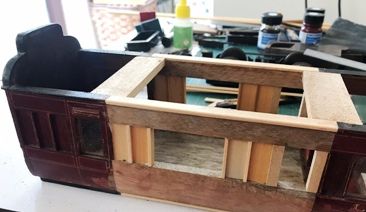
Illustration H8. Another example of excellent renovation work on a Milbro item. This vehicle had been badly damaged, and a new section has been created. It can be seen from the coach end on the left that this factory-built item is a rare example of a Mills clerestory vehicle. The coach is for Gauge One, and more illustrations of it can be seen in our page on Milbro coaches. Many thanks to the owner for letting me have some pictures. I have rarely commissioned a full loco repaint, but this can be desirable even on a high quality item. With the example below it was necessary in order to restore this 1932 Beeson model to the livery it would have had when made. For more photos and discussion of this example see our section about Beeson's 3-rail models.
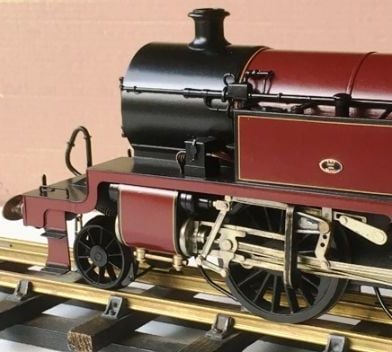
Illustration H9. The master painter Warren Haywood has beautifully restored this 1930s Beeson Fowler tank to its original livery. When it came up on Ebay some years ago it was black, having been repainted unsatisfactorily. Unfortunately, in contrast to this kind of restoration, some 'improvements' to update vintage models have been less satisfactory. The illustration below shows two separate parts that join together to make up a chassis. They are from a Beeson pre-war Royal Scot class model that I believe was most likely supplied to a customer via Exley (or perhaps Milbro). A short front section including parts of the original frames has been retained with the cylinders on it. The rear parts of the old frames have been cut off and removed. A replacement section of chassis designed for 2-rail operation - and containing new wheels with a Bond's motor - was then bolted on. The replacement frame sections are relatively thin, and fit rather crudely onto the front part. Sadly, there is now no way of telling exactly what the original mechanism, frames and gear train were like. Although the front end 'remnant' seen here might be suggestive of a connection to Exley or Mills, that cannot be verified with certainty. In addition, the original connecting rods and allied fittings were partly replaced (probably by the same owner) with modern ones which were not very attractive, but may have appeared more realistic. The coupling rods he used may have been the original ones, but were more like Exley or Bassett-Lowke products than Beeson's. This model (Sherwood Forester) is mentioned again in our page about Beeson, and is awaiting renovations. It is sometimes assumed that Beeson engines were cherished so much that almost all were handed down over the years in very good condition. Unfortunately that is not really the case, especially with 1930s models, although the situation is probably much worse for items built by some of the other makers. 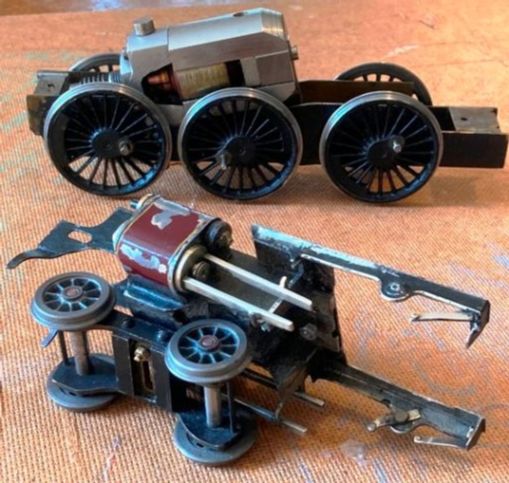
Illustration H10. The front item here includes all that remains of the original frames of a Royal Scot class loco believed to be a model made by Beeson for another firm (probably Exley or Mills). The rest of the chassis has been replaced by the 6-wheel unit standing behind, which is set up with a Bond's motor and for two-rail running, but has been fitted onto the front section rather crudely. It could be argued that this is an example of what not to do when updating a distinctive old model of good quality. One result is that it is impossible to know what the original mechanism was like, or whether the model was sold via Exley (which seems the most likely origin in this specific case).
Collaborations and similarities amongst firms One problem facing anyone trying to identify vintage models is the issue that firms collaborated in a variety of ways. Not only did retailers commission work from manufacturers, but makers might also use sub-contractors or work together. It is widely understood that J.S. Beeson built some locos for Milbro, Exley and Bassett-Lowke, as well as for other companies, and he could also supply commercial customers with parts and fittings when needed. An additional complication is that the production approaches of makers could overlap with each other. One specific instance concerns the construction of loco tenders, where in some cases Exley's pre-war approach parallelled Milbro's. The frames of the tender on the Exley freight loco below are secured by cross-pieces bolted onto the base, enabling them to be removed. That matches one of Milbro's practices (see our page about Mills locos), although this tender is clearly one of Exley's. There is an added further complication, as Beeson also deployed this approach (amongst others) when making some tenders in the 1930s. Looking further, this particular 2-8-0 has additional things in common with Milbro engines, although its loco frames have been cut to accommodate a large Exley motor unit, and its wheels have been pressed on (unlike the wheels normally found on Mills engines). Perhaps before the war these two firms drew on each other from time-to-time when turning out a specific model or small batch. Regarding the LNER engine below, it is worth noting that Milbro built and displayed a GCR R.O.D. 2-8-0 in 1937, and supplied a similar LNER engine for an enthusiast in the same period (see our page on Mills locos for the Model Railway News sources). So it seems likely Milbro could readily have supplied Exley with an unfinished LNER 2-8-0 body and frames, if asked! In any event, this loco would sit very comfortably alongside Milbro's engines. 
Illustration H11. Exley LNER 2-8-0, currently undergoing some tidying-up and minor repairs. This pre-war model has some similarities with Milbro locos. It contains the massively heavy lead weighting sometimes found in Exley models, and a very modest but handsome backhead that might well have been supplied by Beeson. For more pictures of this item see our Exley locos coverage.
Mentioning the overlap and similarities between firms has given me a justification for including this substantial pre-war 0 gauge freight loco model on our home page! I think large goods engine models by top makers from that period can be especially attractive, but they are by no means common. This one would have been an expensive commission for its purchaser.
Sometimes, arrangements for producing an engine might have involved more than two partners. Occasionally the complications make it hard to identify with certainty which maker produced a specific model. I describe one example in our section about Beeson, where it looks as if Mills and Beeson both contributed to an 0 gauge GWR tank engine sold as a special order through Gresham Models. This pannier tank was recently given a very smart overhaul and repaint by Warren Haywood, and we show it now as a nice example of a late-1930s special order. 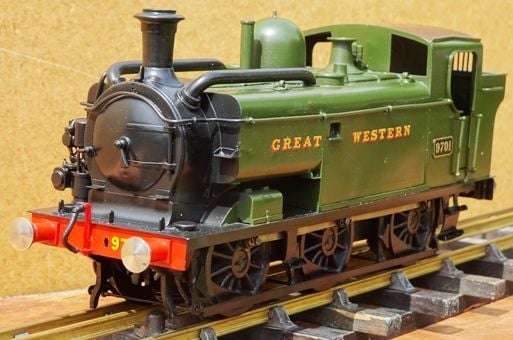 Illustration H12. Gresham Models 'special order' condensing pannier tank from the late 1930s, believed to have been supplied by Beeson with Milbro. Recently overhauled and expertly repainted by Warren Haywood. Couplings had not yet been added when this picture was taken. Milbro Kits and extra detailing; two examples
In the pre-war decades one option for Mills enthusiasts was to use Milbro wooden wagon and coach kits or parts to make their own models. Sometimes these turned out very well, and the example of a six-wheeler below seems to prove that point. This item may have been professionally made by another firm using Milbro components, or might conceivably be a Mills factory special order, but it seems more likely to have been built by an enthusiast (and it has what looks like a date written in pencil underneath). I like this model partly because I had often thought it would be interesting to assemble a similar LNER vehicle from Mills spares but never got around to it (and probably wouldn't have done it so effectively). The model captures Milbro coach style very well, and what I guess is probably a considerable simplification of a full-sized 4- or 6-wheeler seems very much in tune with commercial railway modelling in the 1930s (cf pictures in P. Tatlow, 'Historic Carriage Drawings: Volume 3, Non-passenger coaching stock', Pendragon, York, 2000, pages 22, 23, etc.). There is another photo of this model in our Mills coaches section. 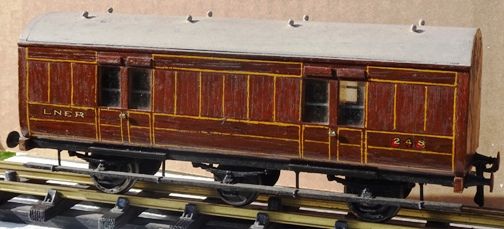
Illustration H13. This is probably a kit-built model using Mills parts, but is very much in the Milbro construction style. Assembly may have been by an enthusiast or another commercial supplier. Its 1930s construction date is written underneath in pencil. For another picture of this vehicle see our section on Mills coaches. Another option was for an enthusiast or a commisioned professional to 'super-detail' a standard Mills wooden item, either of kit or factory origins. I am sure that the firm would have regarded that as very acceptable in the pre-war years, although examples I have seen have often fallen below a good standard. I think, however, that the spirit wagon below is an example of a valiant and competent attempt at an 'upgrade'. It may even have been a professional job. The model might eventually be stripped of some of its extra detailing, be given different wheels, and be restored to 'factory' appearance, but for present purposes it serves as an excellent illustration. 
Illustration H13a. A standard Mills spirit wagon (probably originally factory-made) that was given extra detailing and new wheels many years ago. It has a ladder on the other side (see our Mills wagon page). Artwork and drawings (3 LMC examples)
In a separate page this site features some of the transfers and drawings made by Milbro, but several other companies created similar things in the pre-war years. I hope it might be of interest now to show three examples from the Leeds Model Company from their inter-war period. Two are possibly quite rare items, and one of these highlights something that has almost disappeared from modern modelling; the creation of a freelance design that I guess would have been the basis for an expert loco building commission by Stedman himself in the 1920s. * Unfortunately my hasty photos of the drawings have not been very successful, and I hope to improve on them later. *  Illustration H20. This seems typical of some of the 'information guides' issued by firms when supplying enthusiasts, and seems to have been made in the early 1920s. It was for Gauge 0 and Gauge One. The information offered is a reminder that even a century ago there was a UK 0 gauge market in which enthusiasts could build and develop their own relatively realistic layouts; and of course some made their own locos or rolling stock too. 

Illustration H21a and H21b. These images show a Leeds loco name transfer and the card 'cover' that came with it to give protection. The name seems to have been cut casually out of a larger 'page' that had had more copies of the same name on it. Firms might sometimes make transfers to suit a model they had been building, and prepare multiple copies so as to add them to their sales list. Milbro seems to have done that for the 'Hush-Hush' engine. There were three of these Kitchener transfers together when I found them many years ago, and they might well have been sold by Leeds as parts of a bigger sheet. Perhaps that sheet could even have contained other engine names too. 



Illustrations H22a-H22d. Four hurried images of a Leeds Model Company drawing, with apologies for the poor photo quality and colour variation ! The design is of an engine that (as far as I know) never existed on a UK railway.
This drawing is around 26 inches long, and I struggled to take a viable full photo of it with my simple camera. It has also been very badly damaged, with substantial holes, tears, repairs and replacement material giving it a battered and uneven appearance. At the time I took these pictures (in November 2024), the loco had been drawn almost a hundred years before, so there had been lots of opportunity for deterioration! I don't know if any other copies of this design have survived, or if the related model loco that Stedman might have made has ever been seen. .  Illustration H22e. It seems from the initials that Stedman did the above drawing himself in the mid-1920s. Perhaps this Leeds design was meant to be for a lengthened LNER pacific, given the date. Maybe it reflected the wishes and imagination of a well-resourced client, but I have no further information. In our page on locos by other vintage makers we show a pre-war freelance model that was probably inspired by French engines, and built for a friend of G.P. Keen. Having shown the Stedman drawing, it may be worth saying a little more below about the choices involved.
The issue of 'representation' Before 1939 it was commercially effective for some model-makers to build standard locos that were not true-to-prototype, and were sometimes relatively inexpensive. Milbro's 'standard tanks' of the 1930s are examples. During the inter-war years, however, there were also several UK enthusiasts who envisaged and commissioned high quality models that were inventions rather than representations of existing full-sized engines. Perhaps they wished to feel like the professionals who designed locos for the various railways running in the UK or elsewhere, or the managers and board members who ran these various lines. One or two of these enthusiasts were prominent in the model railway world, and several makers responded to this kind of request. Beeson, Exley and Stedman were well positioned to build freelance models to a very good standard. It seems that after the second world war there was a definite (albeit gradual) rise in expectations about the accurate representation of locos, and interest in freelance models declined amongst those buying or commissioning in the more expensive categories. Some newly-built freelance models still appeared over these years, but perhaps most were the modern equivalents of the relatively plain commercial 'standard tanks' of the 1930s (or made for a larger market as robust and attractive toys). The pathway that eventually became more significant for many serious modellers towards the end of the 'vintage' era was the one pioneered by Norris and Miller, and freelance loco models had little place in that. There was also increasing attention paid to accurate appearance and dimensions with rolling stock. Indeed it is clear that even before the war some enthusiasts wanted more accurate models for their well-detailed locos to haul. Milbro was in a small way one of the several pioneers on this front with its 1930s offer of individual commissioned metal wagons built to accurate proportions. The example below is unusual in having opening doors (fitted characteristically with the help of the split pins the firm used so frequently). Unfortunately I had to repaint it when I first acquired it a long time ago, as there had been too much deterioration (although shadows of Mills tare numbers could still be seen). At that time there was less interest in a model like this than there was in more recent periods. I do not know if the firm attempted to include rivet detail on anything in this series, but that probably seemed less important to enthusiasts than it later became. 
Illustration H25. A van commissioned from Mills in the 1930s, when the firm offered metal vehicles built to more accurate proportions than those in the standard Milbro wooden ranges. This example was restored and repainted quite a long time ago, as it had deteriorated badly. It remains one of my favourite Mills items. We say more about this metal range in our Mills wagons page. The number of these metal wagons built by the company was probably small. What actually constitutes superior representation in railway models is of course open to discusion. Someone might argue that even the simplest of 0 gauge 'live steam' models is actually closer to a full-sized steam loco than a model run from an electricity supply (and perhaps built of materials completely different from the components in a real loco). Nonetheless, nowadays it is usually visual similarity that is referred to when accuracy is invoked. Some vintage makers, however, certainly prioritised the use of steam and the fun of operations, and Bowman in particular showed what could be done very economically. The catalogue image below emphasises the impressive size of the Bowman tank model featured. Bassett-Lowke's well-known live steam mogul models were also good value, and offered over a long period. 
Illustration H26. This catalogue image of a Bowman tank loco is more than ten inches long, and the same size as the actual model. The firm emphasised the 'struggle towards realism' that for them involved models working 'like real ones'. This is a reminder that the interpretations of accurate 'representation' in terms of reproducing body forms and exact external details are not the only ways of thinking about things, although dominant in modern finescale contexts. This image is from the only Bowman Models catalogue I have, and unfortunately its cover is missing (as is its publication date). The firm was based at Dereham in Norfolk, and produced an impressive range of items, including locos, speedboats, stationary engines, rolling stock and track. I should add that despite the merits of live steam models and the usefulnes of the inexpensive standard non-prototypical engines, this website mainly concentrates for practical reasons on firms and products where attempts were made over time to achieve relatively good visual representation. One Gauge 0 Guild member involved with modern modelling indicated to me that from his perspective this site is about the history of finescale. I think that would be too ambitious a goal, but the idea does underline the hope that a variety of enthusiasts may find something here to interest them.
Notes Coverage in the comments and illustrations across the website mostly relates to Gauge 0 rather than to larger scales, but some examples of Gauge 1 (and even bigger) wooden rolling stock are included (see particularly the Gallery section). Enthusiasts often refer simply to 'Mills' locomotives or wagons, as an alternative to saying Milbro or Mills Brothers. Discussion on this site sometimes follows that practice. Please note that permission should be sought from Malcolm Harrison before reproducing anything (text or illustrations) from this website, other than for personal private use. Copyright is retained by the author (or in particular instances by those who have supplied specific photographs).
IN JULY 2025 I FOUND THAT A SMALL SECTION FROM ONE OF MY PAGES SEEMED TO HAVE BEEN REPRODUCED OR LINKED IN AS A DIRECTLY-ACCESSIBLE SOURCE ON AN AUCTION SITE, IN ORDER TO DEMONSTRATE PROVENANCE FOR A LOCO. I DON'T THINK ANY HARM WAS DONE BY THIS, BUT THE USE OF MY MATERIAL IN THIS WAY REQUIRES MY DIRECT PERMISSION (WHICH WAS NOT SOUGHT). A RELATED POINT IS THAT ANY RELIANCE ON A REFERENCE TO OR CITATION OF MY MATERIAL IS ENTIRELY AT THE RISK OF THE PERSON WHO CHOOSES TO USE MY SITE. I DO NOT GUARANTEE ACCURACY OR CERTAINTY IN ANY WAY. OF COURSE I TRY TO GET THINGS RIGHT, BUT CANNOT ALWAYS BE SURE THINGS ARE CORRECT. I have included some photos I have taken of printed items (catalogues, documents, etc.), and also some scanned illustrations. I hope this does not transgress any copyrights held by anyone else, but if so please let me know and accept my apologies. In most cases these items are from firms that no longer exist, or of products advertised many years ago. Acknowledgements, cautions and links
The ongoing preparation of material and illustrations for a site of this kind includes contacting experts and enthusiasts who possess particular locomotives or other items, and have specific experience and insights. Collaboration and consultation are absolutely essential in the case of Milbro, as there are many topics where one’s knowledge is limited, or where discussion helps towards making a better judgement. The same applies to other firms I comment on. General thanks are due to the people from whom I have learned a great deal about vintage railway models in recent years, and who have a wealth of knowledge on specific company products, the building practices involved, and what makes models by various firms distinctive, intriguing or impressive. Amongst these helpful and informative people have been Malcolm Clayton, Simon Goodyear, David and Marcus Peacock, Brian Cain, the late Alan Cliff, Hans van Dissel, John Robinson, Bill Truin, Mike Delaney, and Alan Crompton. Some of these enthusiasts have provided illustrations of specific items for this ongoing project. I am very grateful to Pieter Penhall for providing pictures and insights that have informed and underpinned my accounts of Read Maxwell and Rocket Precision motors. Simon Greenwood has also been a valued expert to consult, especially on matters of construction and finish, while Lee Marsh is a perceptive analyst on historically-interesting models by the top makers. I also want to thank those other enthusiasts, collectors and experts who have come forward with help on rolling stock, engines and other items which have proved invaluable for enlarging my set of illustrations, or to provide information and source materials. Amongst these contributors and correspondents are Nico Atkins, Peter Bishop, Bob Burgess, Mick Bayliss, Roger Ball, Richard Barton, Nick Booker, David Bower, William Brown, Roger Burton, Simon Cook, George Coop, Paul Cooper, Peter Davis, Martin Ford, Hugh Hazelton, Malcolm Holliday, Cyril Kennett, Jonathan Lewis, John Lockwood, John Lumb, John Mawson, Stuart Rose, Alan O'Rourke, Adrian Tester, Mike Williams, Peter Wray, and William Whitehead. As far as literature is concerned I would like to thank Tony Manktelow and Robert Jagger for providing and alerting me to some specific and very informative written material relating to Bernard Miller and W.S.Norris, and Graham Thomas for helping me access a particular important publication in this same territory. Finally, thanks are due for the help of the Gauge 0 Guild's officers (all volunteers) who ran the Slides (DVD and Video Hire) service and the Executor and Trustee service in its later years. The historical material the Guild holds on specific model railway layouts and modellers is a valuable and unique source of information, and considerable gratitude is due for the hard work that was done to preserve and update things so that members could draw on them. I am very grateful to Chris Simpson for his support when I had been looking for material that would help me understand elements of the 0 gauge model railway past. Some qualifications or cautions are necessary about what appears on this site. There may be errors of fact, interpretation or presentation, and if I become aware of these I will try to correct them when text is updated. Identification of items often needs to be tentative, as data or evidence are frequently incomplete. It can sometimes be particularly difficult to determine which company or model-maker built a specific locomotive, and some claims about model locomotives having been made by or for Milbro (or other makers) can turn out to have been misplaced or over-optimistic. As we indicated earlier, there also seem to have been potentially numerous links amongst personnel and between companies making models, with possibilities for work being contracted out for a variety of reasons to another producer or expert model-maker, or commissioned by retailers who then named items as their own. Bassett-Lowke, for instance, sold rolling stock made by other manufacturers, and Milbro catalogues included some accessories and even locomotives not made by themselves. In Milbro’s early years there seems to have been a strong link with the Leeds Model Company. Furthermore, parts and kits could be purchased, and in the case of Milbro wagons and coaches this means that some were assembled by purchasers themselves (see above). What constitutes a Milbro item is therefore not completely straightforward. I hope to increase the links from parts of my text to relevant websites. Some direct links will be made within specific sections of this site (for example a connection is made in the Miller section to a site offering first-rate illustrations of some fine 7mm model locos). As I have often consulted the very useful and well-known Binns Road site (see below), I have similarly inserted links to that site when commenting on Jubb wagons, Bond's, and Windsor Models. There also seems to be growing interest in other countries in providing information and advice about vintage model railways on the internet, along with specific contributions from particular experts, makers and enthusiasts. Some of the sites are first rate, and new ones have been under development. A very nicely-designed vintage trains example I have seen is from Australia (Hornby), while the Fitzroy Locoworks site offers an intriguing view into some impressive ongoing developments (these two links are below). In the UK, most readers will probably already know of the excellent information and images available on the Leeds Model Company, from The Leeds Stedman Trust and the Dutch HRCA. binns road site The Binns Road site has long been an invaluable resource for enthusiasts. Readers can find some very useful Milbro pictures there, including coverage of a Southern coach fitted with lighting pickups, and pictures of the Milbro Hush-Hush and Cock o' the North locos mentioned on our own site. https://www.binnsroad.co.uk/railways/milbro/index.html Hornby Railways (Australian site): Fitzroy Locoworks For links to two sites that contain valuable material on Leeds Model Company items see: | 
